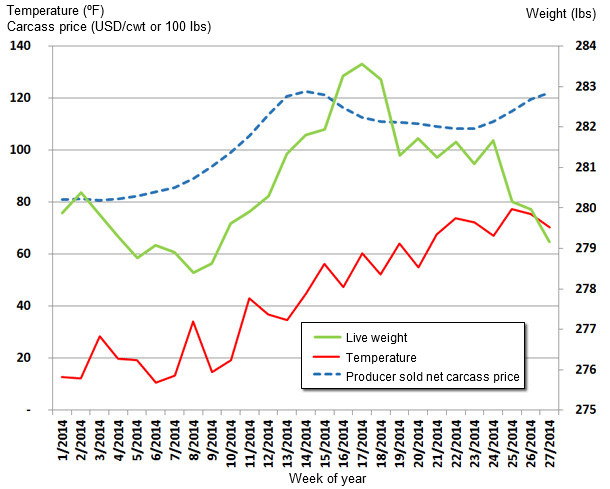First, a quick update on the progress of the summer season and its impact on the average weight of pigs slaughtered in the United States. It’s what you would expect, rising temperatures and falling average weights, however, maybe not as fast as in previous years. As you are probably aware, the US pig weights are at all-time highs for the modern period of production reflecting the unprecedented profit margins being earned due to the substantial and ongoing pig losses related to PEDv coupled with moderating feed costs. This is a very rational response to the present margin opportunities and it is also helped by the reduction of pig stocking densities in many barns which postpones the suppression of average daily gain (the level of crowding in the barns necessary to suppress growth doesn’t happen until in-barn average pig weights are higher on average in an understocked grow-finish space).
Because of this, we expect to see first group marketing from the barns to be at a higher weight and the average weight of the barn before the next group pushes to get in will also be increased. It is typical in the US for producers to sell the first cut from the finishing barn at lower than average target weight to free space for the remainder of the pigs which under certain circumstances allows the growth rate, which has been suppressed by crowding, to “spring back” to normal levels.


Figure 1. Update on US weekly average live weight, carcass price and temperature changes. Source: USDA AMS market news service and University of Dayton.
Figure 1 continues the chart from last month’s article and you will see that temperatures are rising and pig weights are edging down. I am using this as a test year to see if pig weights can be maintained through increased management when outside temperatures are high in the summer months. It’s a good year to test as the incentives to maintaining high pig weights are likely never to be higher. I’m using this to see if all the excuses I get in previous years about how impossible it is to reduce summer weight dropouts, are really true. In fairness, we have had one week of much cooler than normal temperatures for the summer but the heat is returning fast. More on this next time!
We hear a lot of talk about optimizing profitability in grow-finish through reducing standard deviation of marketed weights and aiming that tighter weight group at the profit optimal average weight at the time of marketing. It’s a bit like playing darts, you want the darts to be in tight group but it is also necessary to be near the bull’s eye on the target. A tight group of darts on the wall doesn’t score much. So is the case in finishing marketing, the ideal is tight weight groups at or near the profit optimal weight (which is also a function of the price and the packer bonuses for quality where they exist at each weight).
We do not hear much in the United States about the key factors which underlie outstanding profit performance from the sow herd. Sure, we have lots of articles about individual components of the sow herd like “How to wean 30+ pigs per sow per year”, as well as all kinds of advice about target lactation feed intake, target wean-to-service interval, target weaning age etc. We even see several very nice mathematical models (many from European researchers like Ruud Huirne at Wageningen UR, Netherlands) which solve for the profit optimal culling rate but we rarely seem to see the full package put together so that we understand the sow farm in terms of the profitability of the entire production process through the slaughter of mature animals.
For instance, the separation of the sow farm from the rest of the production process, whether it be a physical separation for bio-security or a business separation, such as the weaned pig producers who sell their piglets to finishers owned by other persons or firms, has led us to think of it as a separate business with its own goals and targets. This separation from the ultimate goal of pig farming, the profitable sale of finished animals, results in this splintering of goals and some confusion. Disengaging the sow farm from the slaughterhouse outcome has led to an almost single minded focus on throughput as the only goal of the breeding herd, so-called “piglets out the door” as high as possible. Luckily, we are beginning to see some research which is attempting to quantify the impact on the final product at slaughter when we make throughput the only goal of the sow farm. There are some conflicting reports coming in on these things but most people realize that the uniquely US error of reducing the weaning age too far, in order to turn sows more frequently and expand throughput per sow, led to serious financial impacts in the grow-finish barn until it was corrected. As strange as this may sound to your ears, it is distinctly not the same thing to say that more pigs per sow means more profits. It’s time to realize that “bigger is not necessarily better” in any sow farm metric except finished animal profitability and it's past time to explore what we seem to have discovered on this topic. That’s where we are headed in the near future in these articles.


